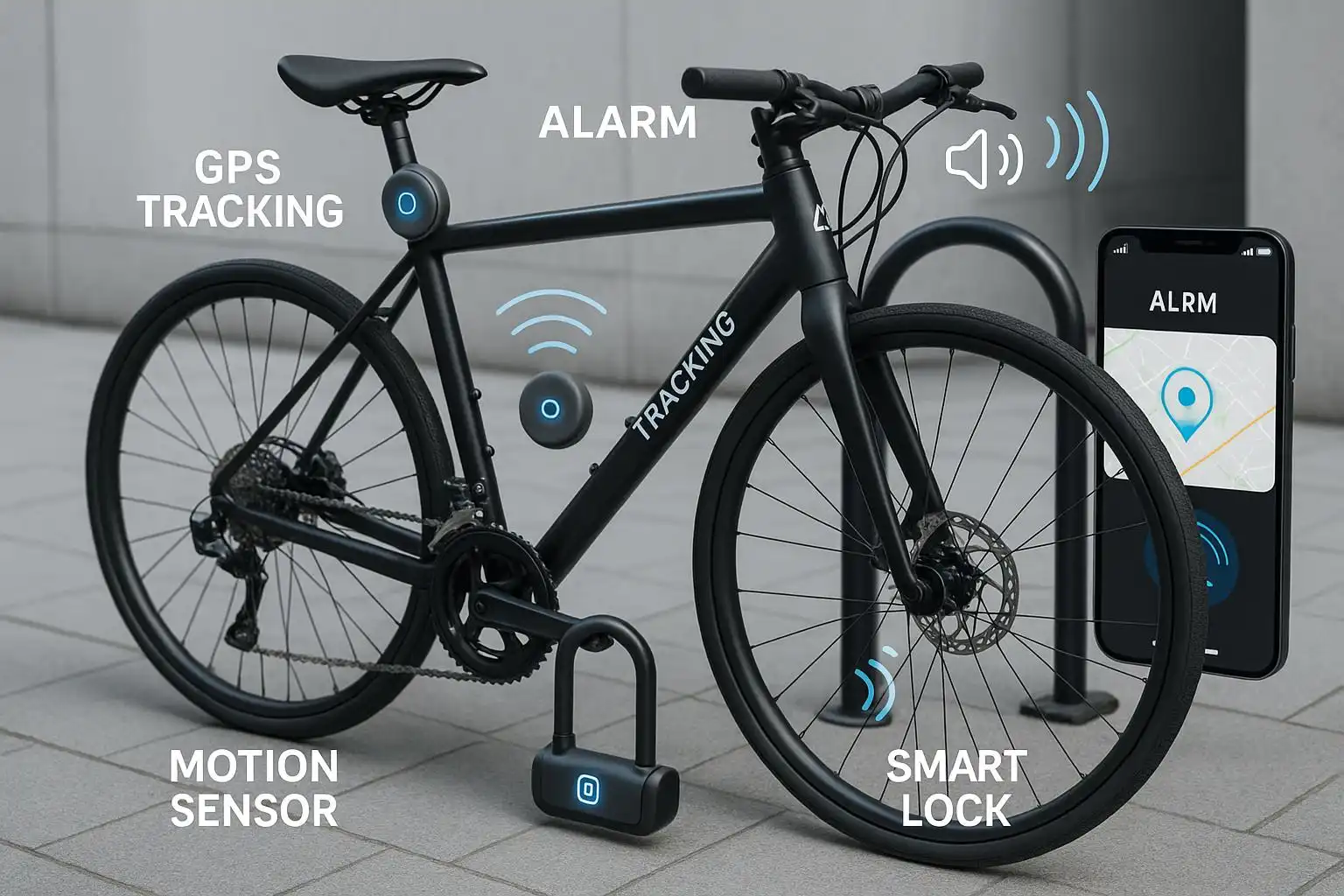The bicycle theft epidemic has reached unprecedented levels worldwide, with millions of bikes stolen annually and recovery rates remaining frustratingly low despite traditional security measures. However, 2025 has emerged as a transformative year in the fight against bike theft, with revolutionary security technologies that combine GPS tracking, smart alarms, angle-grinder resistant materials, and community-based recovery networks to create comprehensive protection systems that are finally turning the tide against bicycle criminals.
The evolution from simple cable locks and basic U-locks to sophisticated smart security ecosystems represents one of the most significant advances in bicycle protection technology in decades. Modern bike security systems integrate multiple layers of protection, from passive tracking devices that leverage smartphone networks to active alarm systems that can detect tampering attempts and alert owners in real-time. The convergence of advanced materials science, wireless communication technology, and artificial intelligence has created security solutions that not only deter theft attempts but also enable rapid recovery of stolen bicycles through precise location tracking and community-based alert networks.
The economic impact of bicycle theft extends far beyond the immediate loss of individual bikes to encompass reduced cycling participation, increased insurance costs, and the broader social costs of crime that affects entire communities. The development of effective anti-theft technology represents not just a technological achievement but a crucial step toward making cycling more accessible and attractive to people who have been deterred by security concerns. The psychological impact of knowing that expensive cycling equipment is protected by sophisticated security systems can encourage greater investment in quality bicycles and increased participation in cycling activities.
The integration of smart security technology with existing cycling infrastructure, from bike sharing systems to personal transportation networks, creates opportunities for comprehensive protection that extends beyond individual ownership to encompass broader cycling ecosystems. The data generated by these security systems provides valuable insights into theft patterns, criminal behavior, and effective prevention strategies that inform both individual security decisions and broader policy initiatives aimed at reducing bicycle crime.

The Evolution of Bicycle Security Technology
The history of bicycle security has been characterized by an ongoing arms race between security technology and criminal methods, with each advancement in protection technology eventually countered by new theft techniques that require further innovation in security systems. The traditional approach to bike security, based primarily on physical barriers such as locks and chains, has proven increasingly inadequate against modern theft methods that utilize power tools, chemical attacks, and sophisticated criminal networks that can defeat most conventional security measures within minutes.
The limitations of traditional security approaches became particularly apparent with the rise of angle grinder attacks, where thieves use portable power tools to cut through even the strongest conventional locks in less than a minute. The development of angle-grinder resistant locks represents a significant advancement in physical security technology, utilizing advanced materials and innovative design approaches that can withstand power tool attacks for extended periods, providing sufficient time for security responses or deterring thieves who prefer quick, quiet theft methods.
The integration of electronic technology into bicycle security systems has opened entirely new approaches to theft prevention and recovery that extend far beyond the physical protection provided by traditional locks. Smart security systems can detect tampering attempts, alert owners to potential theft situations, and provide real-time location tracking that enables rapid response and recovery efforts. The combination of physical and electronic security measures creates layered protection systems that address multiple aspects of the theft problem simultaneously.
The development of community-based security networks represents perhaps the most innovative aspect of modern bike security technology, leveraging the widespread adoption of smartphones and wireless connectivity to create distributed tracking and alert systems that can locate stolen bikes and coordinate recovery efforts across large geographic areas. These community networks transform individual security devices into components of broader protection ecosystems that provide coverage and support that would be impossible for individual security measures to achieve.
The miniaturization of electronic components has been crucial in making advanced security technology practical for bicycle applications, where weight, size, and power consumption are critical considerations. Modern GPS tracking devices weigh less than 25 grams and can operate for months on a single battery charge, making them suitable for integration into existing bicycle components without significantly impacting performance or aesthetics. The development of energy-efficient processors and communication systems has enabled the creation of security devices that provide comprehensive monitoring capabilities while maintaining the compact, unobtrusive characteristics essential for effective bicycle security.
The artificial intelligence algorithms that power modern security systems enable sophisticated analysis of usage patterns, environmental conditions, and potential threat indicators that can distinguish between normal bike handling and suspicious activities that may indicate theft attempts. These systems must account for the enormous variability in bicycle usage patterns, from daily commuting routines to recreational riding and long-term storage, while maintaining high sensitivity to genuine security threats and minimizing false alarms that could reduce system effectiveness and user confidence.
GPS Tracking and Recovery Systems
The implementation of GPS tracking technology in bicycle security applications has revolutionized the recovery prospects for stolen bikes, transforming theft from a virtually unrecoverable loss to a trackable crime that can be pursued with precision and effectiveness. The integration of Global Positioning System technology with wireless communication networks enables real-time location monitoring that can guide recovery efforts directly to stolen bicycles, dramatically improving recovery rates and creating deterrent effects that reduce overall theft rates.
The passive tracking systems, exemplified by devices such as Apple AirTags and Tile Stickers, utilize existing smartphone networks to create community-based tracking systems that can locate lost or stolen bikes without requiring dedicated communication infrastructure. These systems leverage the widespread adoption of smartphones to create distributed tracking networks where any compatible device can detect and report the location of tagged bicycles. The Apple Find My network, with hundreds of millions of active devices worldwide, provides coverage that extends to virtually any location where people carry smartphones [1].
The effectiveness of passive tracking systems depends on the density of compatible devices in the area where a stolen bike is located, making these systems particularly effective in urban environments where smartphone penetration is high. The anonymous nature of these tracking networks ensures privacy protection while enabling effective location services, with device owners never knowing that their phones are contributing to bike recovery efforts. The integration of multiple tracking networks, including Apple Find My, Google Find My Device, and proprietary systems like Tile’s network, provides redundant coverage that increases the likelihood of successful tracking.
The network-enabled tracking devices, such as the Invoxia Bike Tracker and AlterLock system, utilize dedicated wireless networks including Sigfox, LoRaWAN, and cellular systems to provide tracking capabilities that operate independently of smartphone proximity. These systems can maintain connectivity over much larger distances and in areas where smartphone coverage may be limited, making them particularly valuable for tracking bikes that may be moved to remote locations or stored in areas with limited cellular coverage.
The battery life considerations for GPS tracking devices have been optimized through the development of energy-efficient processors and communication protocols that can provide months of operation on a single charge. The Invoxia Bike Tracker, for example, can operate for up to three months on a single charge while providing continuous location monitoring and alert capabilities [2]. The development of low-power communication protocols and intelligent power management systems has been crucial for creating tracking devices that remain functional throughout extended periods without requiring frequent maintenance or charging.
The integration of GPS tracking with smartphone applications provides users with intuitive interfaces for monitoring bike locations, configuring alert parameters, and coordinating recovery efforts when theft occurs. These applications typically include features such as geofencing, which can alert owners when bikes are moved outside designated areas, and historical tracking that can provide insights into usage patterns and potential security risks. The user experience design of these applications is crucial for ensuring that tracking technology is used effectively and that users can respond appropriately to security alerts.
The accuracy and reliability of GPS tracking systems have been enhanced through the integration of multiple positioning technologies, including GPS, GLONASS, Galileo, and cellular tower triangulation, which provide redundant location services that maintain functionality even when individual systems are compromised or unavailable. The combination of multiple positioning systems ensures that tracking remains accurate and reliable across diverse environmental conditions and geographic locations.
Smart Alarm Systems and Motion Detection
The development of intelligent alarm systems represents a significant advancement in bicycle security technology, providing active deterrent capabilities that can prevent theft attempts while alerting owners and security personnel to potential security breaches in real-time. These systems utilize sophisticated sensor arrays and artificial intelligence algorithms to distinguish between normal bike handling and suspicious activities that may indicate theft attempts, enabling targeted responses that maximize security effectiveness while minimizing false alarms.
The Knog Scout Bike Alarm and Finder exemplifies the integration of alarm and tracking technologies, combining an 85-decibel alarm system with GPS tracking capabilities to provide comprehensive protection that addresses both deterrence and recovery aspects of bike security. The device’s motion-sensitive alarm can detect tampering attempts and sound a loud warning that may deter thieves while alerting nearby individuals to the theft attempt. The integration of alarm and tracking functions in a single device provides comprehensive protection while minimizing the complexity and cost associated with multiple security systems [3].
The sensor technologies employed in smart alarm systems include accelerometers that detect movement and vibration, gyroscopes that monitor orientation changes, and magnetometers that can detect the presence of metal tools that might be used in theft attempts. These sensors work together to create comprehensive monitoring systems that can detect a wide range of tampering activities while distinguishing between normal environmental conditions and genuine security threats. The sophistication of these sensor arrays enables detection of subtle tampering attempts that might not trigger simpler alarm systems.
The artificial intelligence algorithms that process sensor data in smart alarm systems have been trained on extensive datasets of normal bike handling and theft scenarios to recognize the patterns that distinguish between authorized use and criminal activity. These algorithms continuously analyze sensor data in real-time, comparing current conditions to known threat signatures and calculating probability scores that determine when alarm responses should be triggered. The machine learning capabilities of these systems enable them to adapt to individual usage patterns and environmental conditions, improving accuracy and reducing false alarms over time.
The communication capabilities of smart alarm systems enable real-time alerts to be sent to owners’ smartphones, security personnel, or monitoring services when potential theft attempts are detected. These alert systems can provide detailed information about the nature of the detected threat, the location of the incident, and recommended response actions. The integration of multiple communication pathways, including cellular networks, Wi-Fi, and Bluetooth, ensures that alerts can be transmitted even when individual communication systems are unavailable or compromised.
The power management systems of smart alarm devices have been optimized to provide extended operation while maintaining the sensitivity and responsiveness necessary for effective security monitoring. The Knog Scout, for example, can operate for 2-6 months on a single charge while providing continuous monitoring and alarm capabilities. The development of energy-efficient processors and intelligent power management algorithms has been crucial for creating alarm systems that remain functional throughout extended periods without requiring frequent charging or maintenance.
The integration of smart alarm systems with broader security networks enables coordinated responses that can involve multiple security measures and response personnel. These integrated systems can automatically activate additional security measures when alarms are triggered, such as activating cameras, notifying security services, or coordinating with other nearby security systems. The networking capabilities of modern alarm systems create opportunities for comprehensive security ecosystems that provide protection beyond what individual devices can achieve.
Advanced Lock Technology and Physical Security
The development of advanced lock technology has focused on creating physical security barriers that can withstand the sophisticated attack methods employed by modern bicycle thieves, particularly the use of portable power tools such as angle grinders that can defeat most conventional locks within minutes. The integration of advanced materials science, innovative design approaches, and manufacturing techniques has produced locks that can resist power tool attacks for extended periods, providing sufficient time for security responses or deterring thieves who prefer quick, quiet theft methods.
The angle-grinder resistant locks represent the current state of the art in physical bicycle security, utilizing materials and design approaches that can withstand sustained attacks from portable power tools. These locks typically incorporate hardened steel cores, ceramic inserts, and specialized alloys that are designed to damage cutting tools and extend cutting times to impractical levels. The development of these materials has required extensive research into metallurgy, ceramics, and composite materials to create combinations that provide maximum resistance to cutting while maintaining practical weight and size characteristics.
The OnGuard RockSolid 8590 and similar angle-grinder resistant locks utilize multiple layers of protection, including hardened steel shackles, anti-drill lock cylinders, and specialized coatings that make cutting extremely difficult and time-consuming.




